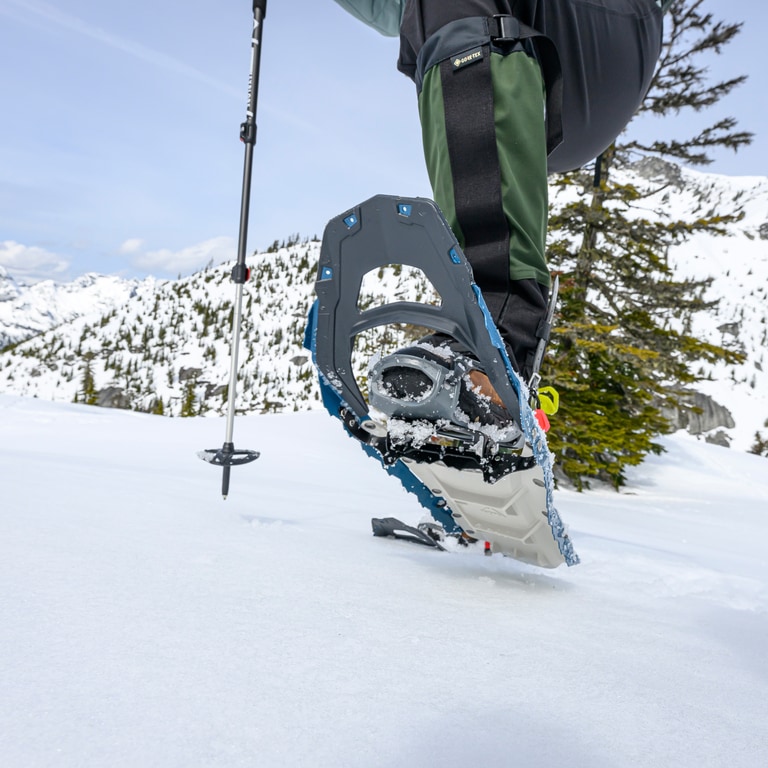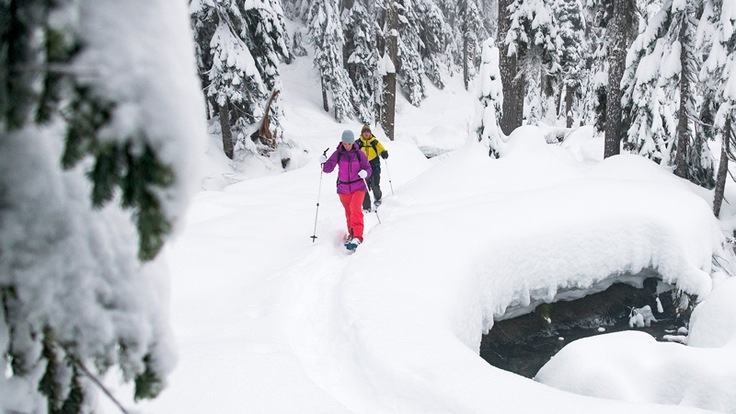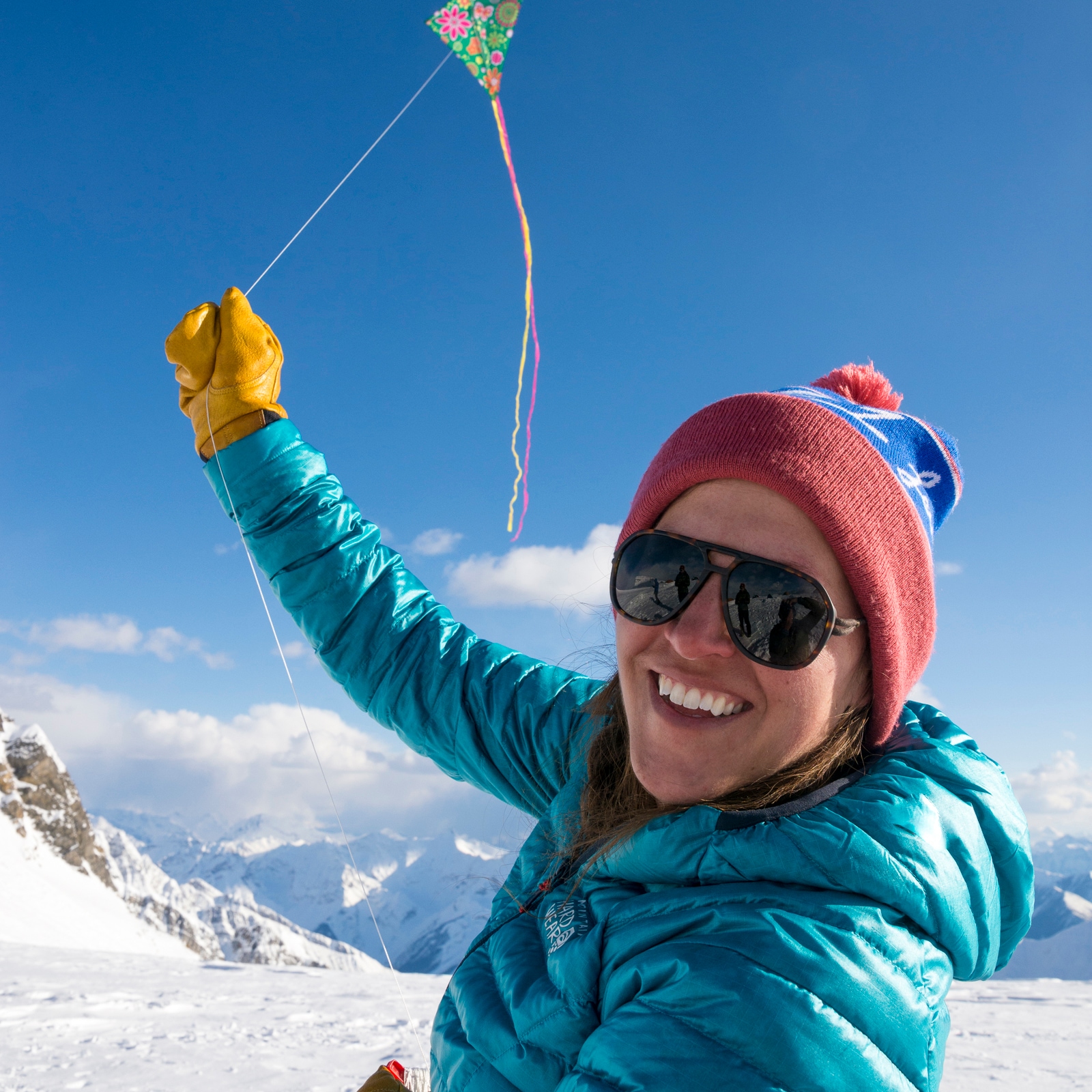Don't let a little snow ruin your hiking season. Come winter, solitude descends on most backcountry areas, softening the landscapes with white. And this new playground is available to you—if you have a little know-how and a good pair of snowshoes.
For the former, visit our Beginner's Guide to Snowshoeing. For the latter, read on. We asked our team of experts to weigh in on their favorite 'shoes available at REI for everything from flats to steeps. They also pinpointed their top choices for beginners and kiddos, plus a great pick for runners. There's a pair of snowshoes in this guide for everyone, which is good news because a season like this comes but once a year.
Staff Picks
Find quick recommendations below or scroll down for in-depth reviews.
- Best Snowshoe Overall: MSR Lightning Ascent Snowshoes
- Best Snowshoe for Beginners: MSR Evo Trail Snowshoes
- Best Snowshoe for Flat or Rolling Trails: Atlas Helium Trail Snowshoes
- Best Snowshoe for Mountain Trails: MSR Revo Ascent Snowshoes
- Most Comfortable Snowshoe: Atlas Montane Snowshoes
- Best Snowshoe for Big Kids: MSR Shift Snowshoes - Kids
- Best Snowshoe for Little Kids: Tubbs Snowflake Snowshoes - Toddlers
Best Snowshoe Overall
MSR Lightning Ascent Snowshoes
Versions Men's 22 in., 25 in. and 30 in.; women's 22 in. and 25 in.
Frame material Aluminum
Binding system Adjustable rubber mesh around the forefoot with a heel strap
Weight 4 lbs. (men's 22 in.), 4 lbs. 3 oz. (men's 25 in.), 4 lbs. 12 oz. (men's 30 in.); 3 lbs. 12 oz. (women's 22 in.), 3 lbs. 14 oz. (women's 25 in.)
It can be tricky to find a snowshoe that performs well across the board—on fresh powder, melted slush, crunchy ice, steeps and more—but the MSR Lightning Ascent ticks all the boxes. It starts with a burly aluminum frame that's ringed with small teeth. A steel toe crampon bites into terrain when you step down, while two underfoot traction bars stabilize the snowshoe when you weight your heel. It's a whole heap of traction that keeps you upright in all but the toughest conditions.
That grip combines with an easy-to-engage heel lift to make the Lightning Ascent at home on climbs. "I feel like a mountain goat when I wear these," says one staffer who's based in Washington's Cascades. They also boast ParagonTM bindings that are not only comfortable on longer hauls, but easy to adjust on the fly. If you're planning on using your snowshoes a lot in a variety of conditions, there may be no better option on this list than the Lightning Ascent. Buy here.
Best Snowshoe for Beginners
MSR Evo Trail Snowshoes
Frame material Steel
Binding system Two adjustable rubber straps to secure the forefoot with a heel strap
Weight 3 lbs. 9 oz.
New to the world of winter walking? Take the MSR Evo for a stroll. A versatile design means these snowshoes float in most types of terrain and snow (no heel lift, though, so you'll feel it in your calves on big climbs). A bombproof plastic deck, meanwhile, doesn't need to be babied. True story: "I've seen the Evo get accidentally run over by a car and survive," one staffer says. We don't recommend that, of course, but the Evo is durable. Steel crampons and traction rails can handle rocks, bare patches and haphazard packing.
The Evo also has an intuitive binding and user-friendly shape. As a unisex snowshoe, it splits the difference between a men's (which is straighter) and a women's (which tapers more), so it should fit most folks. (Read more about gendered snowshoes below.) The binding should also fit most boots, thanks to three straps with a massive range of adjustability.
And for the newbie, you can't go wrong with the price. Buy here.
Best Snowshoe for Flat or Rolling Trails
Atlas Helium Trail Snowshoes
Frame material Aluminum
Binding System Pull webbing around the forefoot with a heel strap
Weight 3 lbs. 9 oz. (22 in.)
If crushing serious distance on sweeping valley floors is your prerogative, the Atlas Helium Trail is the snowshoe for you. At 23, 26 or 30 inches, it's long, and the bigger the dimensions, the better the float; the 30-inch can carry loads up to 270 pounds. But that size belies the Helium Trail's light weight, which is designed to help you go far. Atlas shaves ounces from the snowshoe by carving out holes and slats across the decking, which also help it shed snow. That combo—big size and light weight—lend it to long missions on flat or rolling terrain. (It does have a heel lift but climbing in snowshoes this large can be cumbersome. This shoe also has a really easy-to-use binding that's quick to adjust on the fly, which earned praise from multiple staffers. A webbing crisscrosses the foot and is tightened by simply pulling the glove-friendly loop. By its nature, the webbing secures the foot evenly with no pressure points. To loosen it, you simply pull the same tab the other direction, across the foot. Like the MSR Evo, it has a unisex shape that should fit most snowshoers. Buy here.
Best Snowshoes for Mountain Trails
MSR Revo Ascent Snowshoes
Versions 22 in. and 25 in.
Frame material Steel
Binding system Adjustable rubber mesh around the forefoot with a heel strap
Weight 4.2 oz. (women's) ; 4 lbs. 5 oz. (22 in. men's), 4 lbs. 9 oz. (25 in. men's)
Looking to go up, up and away? You'll need something with maximum traction. The MSR Revo Ascent's perimeter teeth and durable martensite-steel DTX crampons offer the purchase you need when you're on the face, and you'll stick like glue when climbing, descending or sidehilling. Another bonus for vert-seeking snowshoers: an Ergo™ Televator heel lift that's easy to engage with your pole. The Revo Explore has a burly injection-molded ExoTract™ plastic decks that allow subtle torsional flex underfootdeck, boosting your traction, balance, gait and overall comfort as you navigate tricky terrain. Freeze-resistant Paragon™ binding are dialed-in for aggressive control on steep ascents and provide glovelike security without hotspots on descents. The key-lock attachment point design means no-tools-necessary maintenance on the go. Consider snagging a pair of compatible flotation tails (sold separately) if you're hauling loads or need to transition between packed snow and deep powder. Buy women's. Buy men's.
Most Comfortable Snowshoe


Atlas Montane Snowshoes
Versions 23 in., 27 in. (women’s); 25 in., 30 in., 35 in. (unisex)
Frame material Aluminum
Binding system Wrapp™ Swift bindings wrap round the forefoot with two-buckle closure and a heel strap
Weight 4 lbs. (women’s), 4 lbs. 5.3 oz. (unisex)
Mountain hikes require more time in your snowshoes, so if longer treks on inclines, over rocks and on thrillingly uneven terrain are in your future, take a flyer on the Montane from Atlas. The snowshoe's aluminum Reactiv™ frames are designed in a cylindrical-to-elliptical shape with sawtooth traction rails to provide a stronger frame with more nimble response. Durable, flexible Nytex decking and 19° heel lifts allow easy flotation on snow over rolling terrain, and weight-activated rear StabiLock traction lets you dig in and hike over technical terrain. All-Trac™ crampons offer multidirectional grip, and sharp front and rear points help finding stable footing with every step.
The easy-on Wrapp™ Swift bindings are the MVP on these ‘shoes: The easy-cinch rubber straps fit securely for more challenging hiking, with EVA padding that offers warmth in addition to long-lasting comfort and a two-buckle closure that make getting in and out of them a breeze. Options in both women’s and unisex sizing available sizes allow you to customize fit, though the smaller versions aren't best for heavier loads: The 23-inch women’s snowshoe maxes out at 160 pounds, and the 25-inch unisex snowshoe can handle loads up to 200 pounds (both figures include hiker and gear). Size up to the 35-inch unisex for treks that require carrying more: It can accommodate up to 300 pounds. Buy women’s. Buy unisex.
Best Snowshoe for Big Kids
MSR Shift Snowshoes - Kids'
Versions Kids' 19 in.
Frame material Aluminum
Binding system Two adjustable rubber straps to secure the forefoot with a heel strap
Weight 2 lbs. 8 oz.
Everything we love about the Evo, we love about the Shift, which is basically just a 19-inch version of the MSR favorite (above). It sports the same burly, plastic deck and aluminum and steel components, which make it perfect for youngsters who are getting after it this winter. The Shift uses the same binding as the Evo: two adjustable foot straps and a heel strap. It accommodates most boots and provides a secure fit, but it can be tough to operate for younger snowshoers. MSR lists the weight capacity for these around 125 pounds. Buy here.
Best Snowshoe for Little Kids
Tubbs Snowflake Snowshoes - Toddlers'
Versions Toddlers' 14 in.
Frame material Plastic
Binding system Pull webbing around the forefoot and heel
Weight 1 lb. 5 oz.
Step one: Learn to walk. Step two: Learn to walk on snow. The Tubbs Snowflake is designed for the littlest snowshoers (the brand estimates a 50-pound capacity). It's 14 inches long and made primarily of hollow plastic—enough to keep kiddos afloat—but there's no traction. That's good news, though, because sharp objects aren't awesome when Junior takes a digger. Think of these more as an introduction to snowshoeing, so your kid figures out the technique early before graduating to more technical (expensive) snowshoes. Buy here.

Snowshoe Buying Advice
Consider these factors when choosing the best snowshoes for you.
Terrain
Snowshoes are generally designed for flat, rolling or mountain terrain. Casual users can get away with flat-terrain snowshoes, which are easier to use (and often less expensive). They tend to skimp on traction and features in favor of more float. They also have simpler binding systems. The MSR Evo is a great flat-terrain snowshoe.
Mountain snowshoes have more bells and whistles designed for climbing, plus more durable materials. The snowshoes designed for more mountain use in this guide are the MSR Lightning Ascent, MSR Revo Ascent and Atlas Montane.
The Atlas Helium Trail lives somewhere in between with enough features for basic climbing—or rolling terrain.
Size
Snowshoes often come in several sizes, which will translate to varying levels of float. In general, the bigger the snowshoe the better it floats. You'll want a big snowshoe if you're planning on tromping through deep powder.
The flip side is that bigger snowshoes are often more cumbersome and awkward. If you're sticking to packed snow or groomed trails, you can get away with a smaller model, which will feel more natural.
The other thing to consider is that different-size snowshoes often have different weight capacities. These are not hard-and-fast rules but a brand's assessment of the amount of weight the 'shoe can handle and still perform (read: float) as advertised. Heavier hikers and hikers hauling a lot of gear will require a greater surface area to float in soft snow.
Profile
In general, snowshoes are created in three categories: unisex, women's and men's. Think of women's snowshoes more as snowshoes for folks with narrower stances. They're widest at the toe and taper toward the tail, which allows for a more comfortable, natural stride. This shape also helps reduce hip and knee stress and can lessen the chances of a painful, snowshoe frame-to-ankle encounter.
Men's snowshoes—or snowshoes for hikers with a wider stance—don't taper.
If a snowshoe is considered unisex, it likely splits the difference.
Related Articles
Methodology
We asked REI Co-op experts and snowshoeing fans for their favorite models on shelves at REI. They reported back with their top picks for mountain climbs, runs, kids and everything in between. These seven pairs are their faves.




![Lightning Ascent Snowshoes - Men's [Top view (Black)]](/media/fb07c9e1-dcec-4dfc-8cfe-0c46971f55dd/?size=440)
























